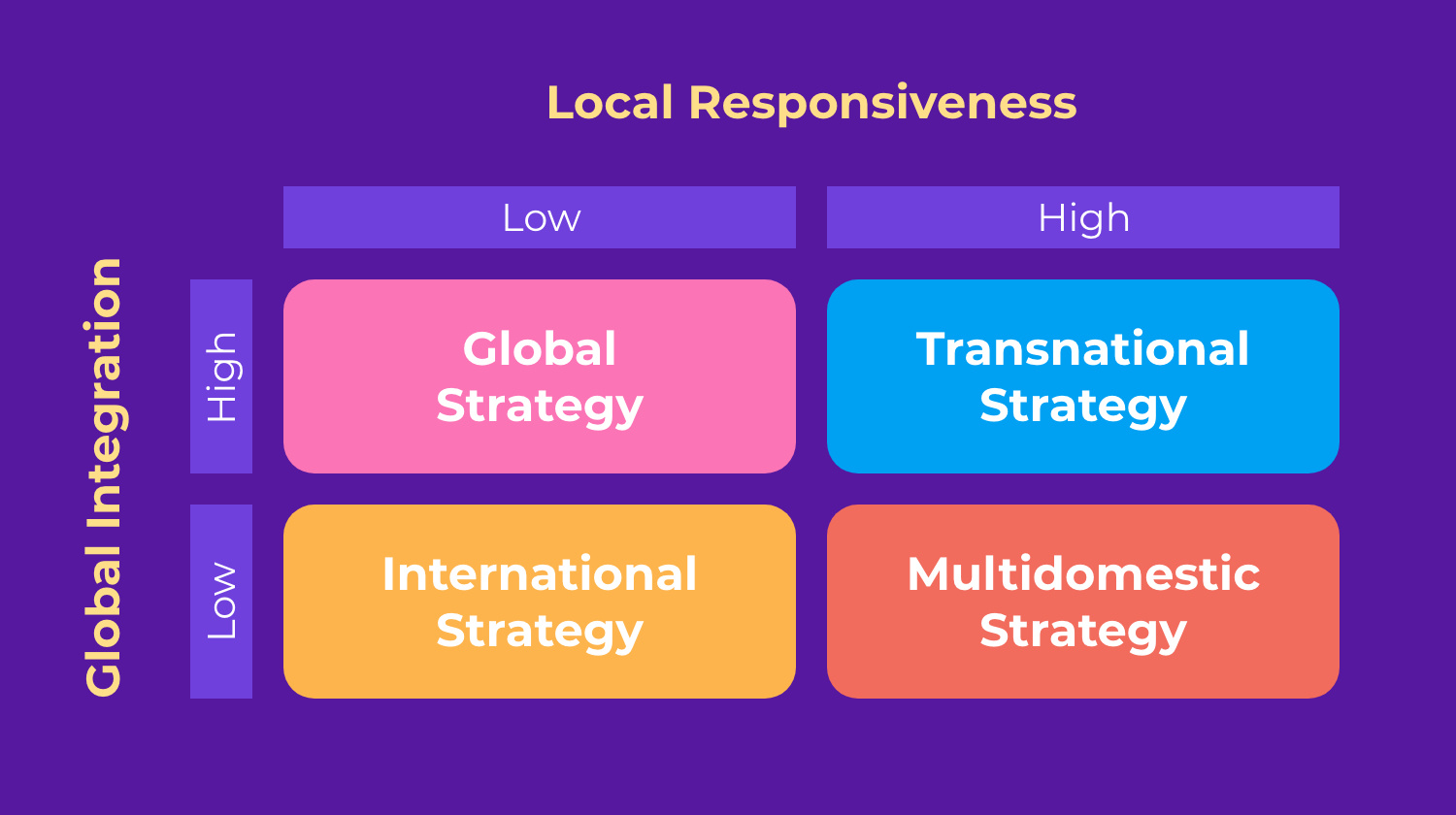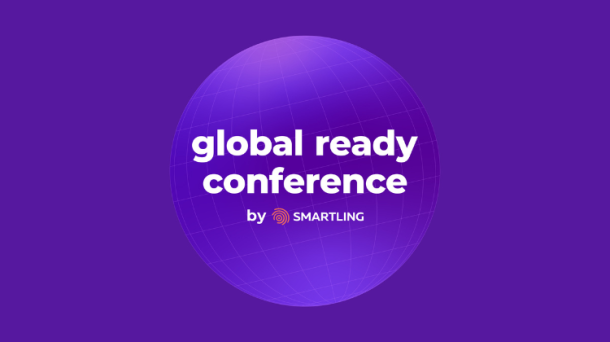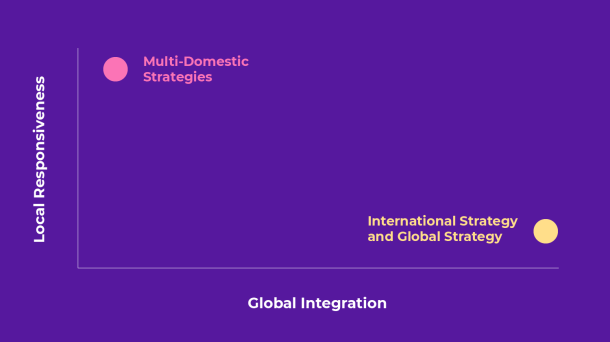What’s your competitive advantage?
It’s one of the fundamental tenets of a powerful business strategy. For multinational companies, it’s what separates your brand from others in increasingly crowded markets. Traditionally, this meant producing goods more cheaply or efficiently.
In today’s ecommerce- and software-dominated world, though, your competitive advantage is just as likely to come from your leadership, marketing, and international strategy.
In this post, we’ll explore the different types of global strategies businesses can choose and the pros and cons of international strategy, often known as the exporting strategy.
What is an international strategy?
Any company that ships worldwide or provides services to consumers or businesses in other countries is considered a global company. An international strategy is usually the first approach most businesses take with global expansion: exporting or importing goods and services while maintaining a head office or offices in their home country.
Global expansion as a business doesn’t have a one-size-fits-all approach. As companies grow and scale, they may choose to invest more in their target markets.
In fact, companies choose from a variety of models, including:
- Transnational Strategy: Transnational businesses operate with a central or head office in one country that coordinates local subsidiaries in international markets. This organizational structure means that there is one overarching brand and center of operations that determine overall decision-making and supply chain management, harnessing the power of scale. Companies McDonald’s, Nike, and Coca-Cola use this model.
- Multi-Domestic Strategy: When businesses use completely different sales, marketing, and product strategies based on the specific companies they’re operating in. Rather than one global brand, there are many smaller, country-specific brands tailored to local tastes and local customers. Big-name wellness brands like Johnson and Johnson use this model.
- Global Strategy: When businesses define one global brand, making little to zero changes for other markets. Tech giant Apple is a great example of this - the technology is the same (with a few minor changes in keyboards) wherever you go.
Companies don’t often choose one model forever. What may start as an international strategy can morph into a transnational or multi-domestic one.
What international business strategies look like in practice
Any international business strategy balances two sides of one graph:
- Global integration: How centralized operations are vs. globally distributed
- Local responsiveness: How customized a product or service is to a local economy vs. completely standardized

An international strategy ranks low on both global integration and local responsiveness since it’s essentially an extension of a business’ domestic strategy.
With this model, international businesses operate with a central or head office. Rather than use subsidiaries or local branches, an international business keeps a head office in one location, usually their home market. This organizational structure means that there is one center of operations and brand and little to no infrastructure investment in other countries.
Choosing an international business strategy gives you several advantages:
- A global, standardized brand that is immediately recognizable
- More efficient processes and consolidated management with economies of scale
- Lower costs with centralization and streamlined operations
- Simpler product portfolio
However, there are some trade-offs companies make by pursuing an export-driven strategy:
- High taxes and tariffs for import and export
- Coordinating supply chain management
- Customer service, especially with time zones, languages, etc.
- Driving demand and awareness
- Localization and translation (Don’t worry — we can help with that!)
Regardless of these challenges, an international strategy is by far the most popular for businesses, especially as they take their first steps toward globalization and international expansion to different countries. If you’re not sure how your products will respond to different markets, or just want to test it out, following the export model is the safest option.
The power of international marketing
One of the biggest challenges for international businesses is driving demand and awareness in local markets.
Because these businesses are less embedded in local customs or languages, it can be difficult to know how to appeal to these consumers.
That’s why the most successful international businesses invest heavily in marketing, rather than infrastructure, so they can scale without needing to be on the ground in a foreign market. With a centralized model, headquarters maintains tight control of product and branding, making it easy for one consistent message across multiple countries.
As you expand, a strong localization strategy — ensuring that your message and marketing sounds and feels the same across multiple markets, regardless of language — is what makes international marketing so powerful.
We’ll dive into specific examples of international businesses in a moment, but consider one of the best general examples of international marketing at work: regional and country-specific items.
There’s a reason why French Champagne is the celebratory sparkling wine people turn to, even with plenty of alternatives from other countries or regions. And why speed-obsessed car lovers only buy from Italian companies like Ferrari. Regardless of the specific brand, the idea that the best sparkling wine or the fastest car can only come from one place is what’s going to make the international business model work.
To expand globally in this way, you must find a gap that can’t be already found in that market — and build trust that you’re the only brand that can fill that gap.
Implement a solid international strategy with Smartling
The good news? While localization and translation may seem like the most daunting aspects of an international business strategy, they don’t have to be.
Smartling offers a world-class translation software solution built for you, however you plan to scale your business. You can professionally translate and localize all of your content across devices and platforms without sending a single email, touching any button, or managing strings in spreadsheets...no matter how many markets you choose to enter.
Want to learn how you can deliver one unique brand voice to every global market? Jumpstart your localization process with Smartling's easy-to-use localization style guide template.
5 International strategy examples
A successful international business model focuses on a single point of operations while exporting products and services around the world.
While not every global business looks exactly the same, in practice, it means international businesses must take a big-picture, standardized approach to their exports and imports, even as their operations remain small.
Take five of these successful global brands:
-
Moet & Chandon: Owned by LVMH, the iconic champagne is known to be one of the best since 1842 — and one of the most popular in a $700 million market, boasting a celebrity-packed history from Napoleon to the Oscars. Owning over 2,000 acres of vineyards across 200 crus, every bottle is grown, produced, and shipped from France.
-
Red Bull: Most Americans have no idea that Red Bull is an Austrian brand, not an American one. While today’s business model is more transnational, they began as a small exporting manufacturer in 1987, giving out free samples to adrenaline junkies in the United States and exporting from their offices in Europe. Now, the leading energy drink does more than $2 billion in sales every year.
-
Porsche: Cars use hundreds of parts manufactured from around the world. But most of today’s big-name car brands — even international ones like Toyota, GM, or BMW — have production plants in the US, Mexico, and Canada to serve North American customers. Luxury brands like Porsche may use parts from all over the world, but they’re still assembled in their flagship factories in Zuffenhausen and Leipzig, Germany.
-
Victoria’s Secret: The popular 2000s lingerie chain looks and feels exactly the same regardless of where in the world you’re purchasing clothing — sizes, colors, and styles. While their manufacturing comes from around the world, they rely primarily on an export model and opening stores in smaller locations like malls and airports as their point of entry.
-
Netflix: Streaming giant Netflix uses a robust translation strategy with subtitles in 62 languages to scale their business without needing to invest in local infrastructure. With over 200 million subscribers in 190 countries, there are plenty of local options to explore. While the library of available shows in places like India, Brazil, or Japan may change due to licensing agreements, the top-watched shows like House of Cards, Peaky Blinders, Black Mirror, and more remain the same.

.jpg)
%20How%20to%20create%20a%20localization%20style%20guide%20Template%20and%20tips%20(600%20x%20200%20px).png?width=600&height=200&name=(600x200)%20How%20to%20create%20a%20localization%20style%20guide%20Template%20and%20tips%20(600%20x%20200%20px).png)





